¿Su página de acceso a WordPress sigue actualizándose y redirigiéndose cuando intenta acceder / acceder a su sitio web?
Este problema bloquea el acceso al área de administrador de WordPress, por lo que no se ha podido trabajar en el sitio web.
En este artículo, le mostraremos cómo corregir el problema de actualización y redirección de la página de acceso de WordPress.
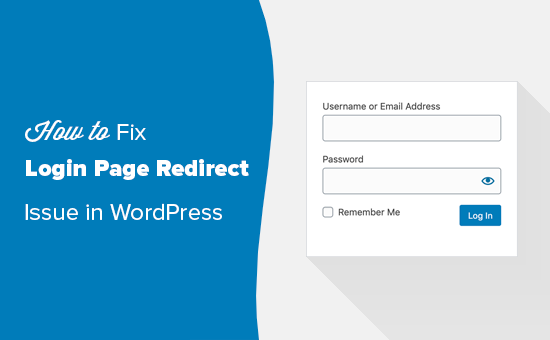
¿Cuál es la causa del problema de actualización y redirección de la página de acceso en WordPress?
El error de actualización y redirección de la página de acceso de WordPress suele deberse a ajustes incorrectos de la URL de WordPress o a que no se han establecido las cookies de acceso.
Normalmente, cuando accedes, WordPress valida tu nombre de usuario y contraseña y luego establece una cookie de acceso en tu navegador / explorador. Después, te redirige al escritorio de WordPress.
Si WordPress no establece la cookie de acceso correctamente o la URL de su área de administración de WordPress es incorrecta, será redirigido de nuevo a la pantalla de acceso en lugar de al escritorio de administrador.
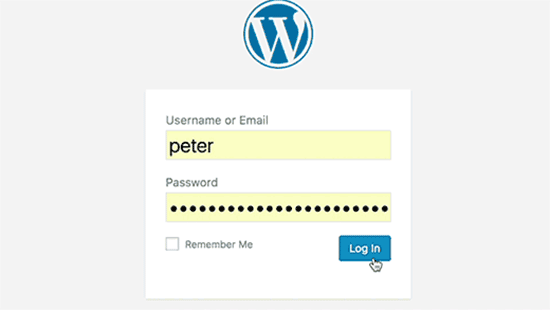
Los problemas de acceso / acceso también pueden ser causados por diferentes errores de WordPress, como el error al establecer la conexión con la base de datos, error interno del servidor, o la pantalla blanca de la muerte.
Con esto en mente, vamos a diagnosticar y corregir el problema de redirección y actualización de la página de acceso de WordPress. Puede utilizar estos enlaces rápidos para saltar a un método específico:
Nota: Si desea probar los pasos avanzados de este tutorial de WordPress, cree primero una copia de seguridad de su sitio. Consulte nuestra guía sobre cómo crear manualmente una copia de seguridad de la base de datos de WordPress.
Tutorial en vídeo
Si no le gusta el vídeo o prefiere la versión escrita, siga leyendo.
Método 1: Vaciar cookies para resolver problemas de acceso / incidencia
WordPress utiliza cookies para la identificación de acceso, por lo que el primer paso para diagnosticar problemas de acceso a WordPress es el más sencillo. Deberá vaciar las cookies y la memoria caché de su navegador / explorador.
En Google Chrome, basta con hacer clic en el menú de ajustes del navegador y seleccionar Más herramientas ” Vaciar datos de navegación.
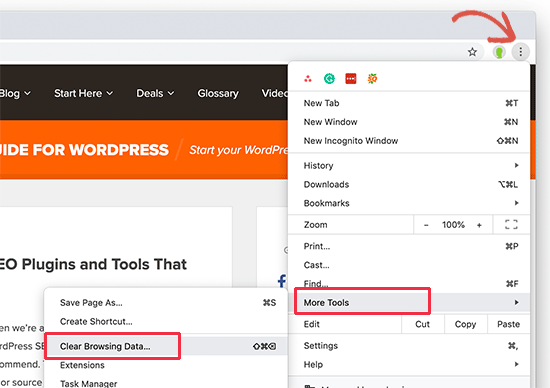
Se abrirá la página de ajustes de Chrome con un mensaje / ventana emergente “Vaciar datos de navegación” en la pantalla.
Desde aquí, debe seleccionar las opciones “Vaciar cookies y otros datos del sitio” e “Imágenes y archivos almacenados en caché”.
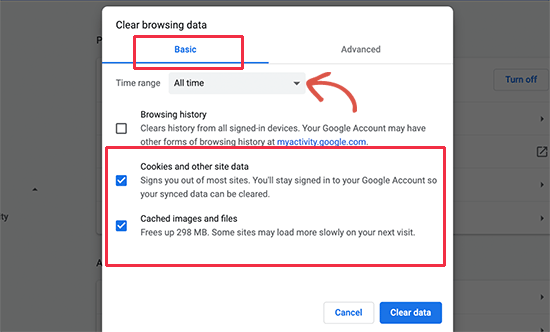
A continuación, haz clic en el botón “Borrar datos” y Google Chrome vaciará la caché del navegador.
Asegúrese también de que su navegador tiene activadas las cookies. Una vez hecho esto, reinicia el navegador e intenta acceder. Esto debería corregir el problema para la mayoría de la gente.
Tenemos una guía completa con capturas de pantalla que muestran cómo vaciar la caché y las cookies en los principales navegadores.
Método 2: Actualizar los ajustes de URL de WordPress
WordPress viene con ajustes para la URL de su sitio web y la URL de su instalación de WordPress.
Si tiene acceso al área de administrador de WordPress, podrá ver esta opción en la página Ajustes ” General.
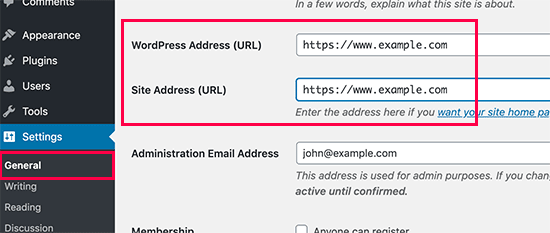
Si estas URLs son incorrectas, WordPress le redirigirá de nuevo a la página de acceso.
Dado que no se ha podido acceder al área de administrador de WordPress, deberá editar el archivo wp-config. php para corregir este problema.
El archivo wp-config.php es un archivo especial de WordPress que contiene los ajustes importantes de WordPress. Puede acceder a él mediante un cliente FTP o a través de la aplicación Administrador de archivos en el escritorio de WordPress de su cuenta de alojamiento.
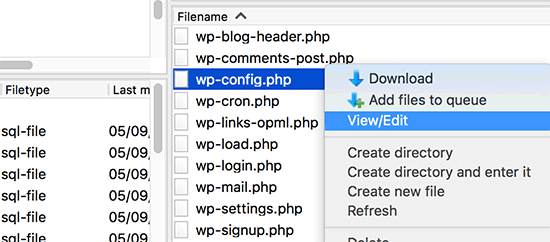
Encontrarás el archivo wp-config.php en la carpeta raíz de tu sitio. Simplemente edite el archivo y pegue las siguientes líneas de código justo antes de la que dice: ‘ ¡Eso es todo, deje de editar! Feliz publicación'.
define('WP_HOME','https://www.example.com');
define('WP_SITEURL','https://www.example.com');
No olvide sustituir “ejemplo.com” por su propio nombre de dominio.
Después, guarda los cambios y vuelve a subir el archivo a tu sitio web.
Ahora puede visitar su sitio web de WordPress e intentar acceder. Esperamos que esto haya corregido el problema. Si no es así, sigue leyendo para diagnosticar otros problemas.
Método 3: Borrar archivo .htaccess en WordPress
A veces, el archivo .htaccess puede corromperse, lo que puede provocar errores internos del servidor o el error de actualización de la página de acceso.
Sólo tienes que acceder a tu sitio web mediante un cliente FTP o a través de la aplicación de gestión de archivos del panel de control de tu proveedor de alojamiento.
Una vez conectado, localice el archivo .htaccess en el directorio raíz de su sitio web y descárguelo a su ordenador como copia de seguridad.
Si no puede encontrar su archivo .htaccess, esta guía sobre por qué puede faltar su archivo .htaccess puede ayudarle.
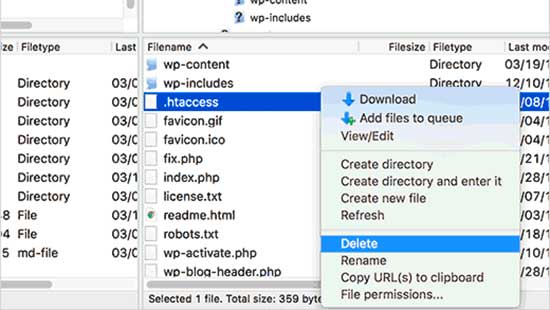
A continuación, borre el archivo .htaccess de su sitio web.
A continuación, abra el directorio wp-admin, y si hay un archivo .htaccess allí, entonces seguir adelante y borrarlo también.
Ahora puede intentar acceder a su sitio web de WordPress. Si lo consigue, significa que su archivo .htaccess le impedía acceder a WordPress.
Una vez que haya accedido, simplemente vaya a la página Ajustes ” Enlaces permanentes en el panel de administrador de WordPress y haga clic en el botón “Guardar” sin realizar ningún cambio. Esto generará un nuevo archivo .htaccess para tu sitio web.
Método 4: Desactivar todos los plugins de WordPress
A veces, los plugins de WordPress pueden causar este problema, especialmente si hay un conflicto entre dos plugins.
Para desactivar fácilmente todos sus plugins de WordPress, conéctese a su sitio web mediante un cliente FTP o a través de la aplicación Administrador de archivos del panel de control de su cuenta de alojamiento web.
Una vez conectado, vaya al directorio /wp-content/. Dentro de él, verá una carpeta llamada ‘plugins’. Aquí es donde WordPress instala todos tus plugins.
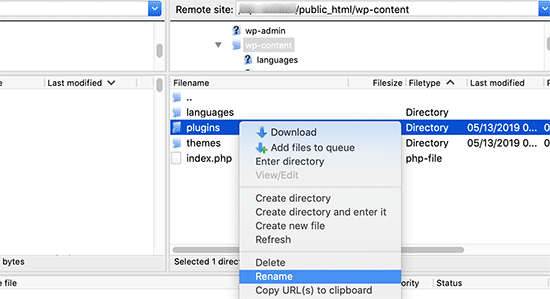
Simplemente renombra la carpeta de plugins a ‘plugins_backup’. Esto desactivará todos los plugins de WordPress instalados en su sitio web.
También tenemos un tutorial detallado sobre cómo desactivar todos los plugins de WordPress cuando el administrador de WordPress es inaccesible.
Una vez que haya desactivado todos los plugins, intente acceder a su sitio de WordPress. Si lo consigues, significa que uno de tus plugins era el causante del problema / conflicto / incidencia.
Método 5: Volver al tema por defecto
Los temas de WordPress también pueden causar conflictos tras la actualización a una versión más reciente de WordPress o del propio tema. Para averiguar si el problema lo está causando tu tema, tendrás que desactivarlo.
El proceso es similar a la desactivación de plugins. Conéctese a su sitio web utilizando un cliente FTP. Luego, debes ir al directorio /wp-content/themes/ y renombrar el directorio de tu tema actual a ‘themes_backup’.
Una vez hecho esto, intente acceder de nuevo. Si lo consigue, significa que el tema era el causante del problema / conflicto / incidencia.
Ahora puedes reinstalar una copia nueva de tu tema para ver si se resuelve el problema / conflicto / incidencia. Si el problema reaparece, tendrás que ponerte en contacto con el soporte de tu tema o cambiar a otro tema de WordPress.
Esperamos que este artículo te haya ayudado a resolver el problema / conflicto / incidencia de actualización y redirección de la página de acceso / acceso de WordPress. Es posible que también desee ver nuestra guía completa para diagnosticar problemas de WordPress o comprobar nuestras mejores selecciones de los mejores plugins de WordPress y herramientas para hacer crecer su sitio.
If you liked this article, then please subscribe to our YouTube Channel for WordPress video tutorials. You can also find us on Twitter and Facebook.





Syed Balkhi says
Hey WPBeginner readers,
Did you know you can win exciting prizes by commenting on WPBeginner?
Every month, our top blog commenters will win HUGE rewards, including premium WordPress plugin licenses and cash prizes.
You can get more details about the contest from here.
Start sharing your thoughts below to stand a chance to win!
Goxi says
You safe my life man! Just messed around the login wp admin site if it wasn’t for this tutorial I would never have solved the problem!
WPBeginner Support says
Glad our guide was helpful
Administrador
Tomer says
Thank you very much for this tutorial!
I have tried these methods and managed to temporarily fix the problem.
The thing is, that after everything seems to be working again, the next day it happens again. Without me changing anything at all. Any tips on that?
WPBeginner Support says
You would want to reach out to your hosting provider to ensure there is nothing on their end that could be causing this conflict
Administrador
Sulivan says
For those who ended up here an after all steps could’t solve this, check if you changed table prefix. I have changed mines and just figured out that there are some usermeta that stores the old prefix.
WPBeginner Support says
Thanks for sharing what was the issue on your site
Administrador
shahin says
thank you bro , amazing content and very useful
WPBeginner Support says
Glad you like our content
Administrador
Julie says
Tks a lot ! You save me !
WPBeginner Support says
You’re welcome, glad our guide could help
Administrador
Ann says
Thanks a lot to all of you, and specially to Hand: Changing back php version to 7.3 solved this for me!
WPBeginner Support says
Glad the recommendations could help you
Administrador
Hand says
I had this issue and spent an entire day trying every possible solution mentioned here and elsewhere without any progress. Then I remembered that I had changed the PHP version from 7.3 to 7.4 on my hosting’s control panel (DirectAdmin). Changing back php version to 7.3 solved this for me.
WPBeginner Support says
Thanks for sharing the solution that worked for you
Administrador
Jeff says
This worked for me.
Joe says
I’ve just worked out that PHP 7.4 missed three of the extensions we had installed on PHP 7.3:
php74-php-opcache
php74-php-process
php74-php-soap
As soon as they were enabled and provisioned the wp-admin 404 error disappeared. Hope that helps you to upgrade to 7.4 trouble-free!
Shiv says
Hi
I followed this article and in my case i found one plugin was causing this issue.So it found it by renaming each plugin and keep trying the login and once i reached this plugin and renamed it …admin login worked.So…i renamed back rest of the plugins to their original names and keep this once renamed and admin worked and later i sorted my plugin
Thanks
WPBeginner Support says
Glad you were able to get your site working and thanks for sharing the method you used for other users with this issue
Administrador
mark says
I deleted the htaccess file as instructed, and now I can’t get a login screen at all. No access to my site (404)
WPBeginner Support says
To check for the possible issues, you would want to go through the steps in our article here: https://www.wpbeginner.com/beginners-guide/beginners-guide-to-troubleshooting-wordpress-errors-step-by-step/
Administrador
Di says
Thanks, you’re a life saver. The .htaccess hack worked!
WPBeginner Support says
Glad our recommendation could be helpful
Administrador
gho says
I owe you one! I used the codes and it’s simply worked. Big thanks wpbeginner!
WPBeginner Support says
Glad our guide could help
Administrador
Giang Nguyen says
thanks man. Your Update Site URL works!
I tried to manually install piece by piece in my local macbook, to learn how wordpress work, and missing your piece!
The install manual doesn’t really have this kind of info =)
giang
WPBeginner Support says
Glad our recommendation could help you
Administrador
Todd says
I’ve had this issue before many years ago and I think my fix was the same this time as it was then. After trying many many suggestions above, what finally did it for me was clearing my chrome browsing history. Someone mentioned trying that and not working, but this was not actually offered as a solution so I thought I would post it. Thanks!
WPBeginner Support says
Thanks for sharing what worked for you
Administrador
Peter says
I was having a login error where my login page keeps refreshing and redirecting me back to the login screen. And for me (I tried all of the above solutions) and none of them worked.
Then I checked the error_log file on my WordPress site and saw that the problem I was having said “WordPress database error Disk full”
As a result, I went into my wp-config.php file and added the following code to file right above the text line where it says in the file “* That’s all, stop editing! Happy blogging. */”.
The code I added is:
define(‘WP_MEMORY_LIMIT’, ‘256M’);
Problem solved.
WPBeginner Support says
Thanks for sharing the solution that worked for you
Administrador
Chris says
Thanks for this – it worked perfectly and tehe memory limit solved the problem. I was really angry because all other stuff like plugins, themes, .htaccess didn’t work!!!
Greetigs Chris
purushotham says
i am not able to login my wordpress admin ,getting 404 error.what should i do to reslove the issue.
WPBeginner Support says
For a starting point, you would want to reset your permalinks using: https://www.wpbeginner.com/wp-tutorials/how-to-fix-wordpress-posts-returning-404-error/
If that does not solve the error then you could try the troubleshooting steps in our guide here:
https://www.wpbeginner.com/beginners-guide/beginners-guide-to-troubleshooting-wordpress-errors-step-by-step/
Administrador
Travis says
None of these options worked for me… Turns out to be a hosting issue. Called Network Solutions and they said that because my database was over 300mb I needed to upgrade my database because after 300mb they lock you out…. Upgrading by DB fixed the issue. Who knew….?!
WPBeginner Support says
Glad you were able to find the solution to the problem
Administrador
Chris says
How did you upgrade the WP database? I think this may be my problem.
WPBeginner Support says
You would reach out to your hosting provider and they would let you know if you need more space for your database similar to Travis
Administrador
hamdi says
Defining these lines ON TOP OF wp-config.php helped. They don’t help if you put them at the bottom.
define(‘WP_HOME’,’http://example.com’);
define(‘WP_SITEURL’,’http://example.com’);
WPBeginner Support says
It should still work if you place it at the bottom of the wp-config file, there may have been a problem with where you placed it depending on what’s in your specific wp-config file.
Administrador
Joe G says
Nothing worked for me until I went into ftp server and edited index.php in the site’s root (alongside all of the other wp-related files mentioned here), and set define( ‘WP_USE_THEMES’, FALSE )
This will temporarily break your site temporarily (no error codes, just white screen), though my site loading wasn’t the problem. This allowed me to finally access my dashboard through the login site, where I then put a brand new theme on and fixed what I thought might be the culprit (I made the mistake of redirecting my “Home” link on my menu to an exterior site).
After removing the “Home” link, (or just to be safe, the menu in general), and creating a new menu with only the pages in question I wanted to use, I re-set the ‘wp_use_themes’ to TRUE and we’re back off to the races again!
WPBeginner Support says
Thanks for sharing what worked for you
Administrador
Mohsen says
I’ ve tested all of these solutions, but my problem has not solved.
WPBeginner Support says
If none of these methods worked then you may want to reach out to your hosting provider to ensure there aren’t any issues on their end.
Administrador
Matt Nigro says
My issue is that everyone has access to my site…no login required! Can someone help.
WPBeginner Support says
Do you mean people can view your site or people can log in to your site? If you mean the login then if you’ve logged in once, WordPress should log you back in but your site’s visitors would still need to log in. If you visit your site in an incognito browser you should see what your visitors see.
Administrador
Pranay Singh says
I am unable to login to the wordpress admin page as it is showing too many redirects(error) as I had just installed the wordpress and since then I am unable to login the page I have made every change and have checked each possible way through which I can make changes. I have done everything but nothing works. Please help me with the issue.
WPBeginner Support says
For the too many redirects error, you would want to take a look at a different article of ours located here: https://www.wpbeginner.com/wp-tutorials/how-to-fix-error-too-many-redirects-issue-in-wordpress/
Administrador
Peter Guckian says
For some reason, everytime I go to login into my work’s cms site it redirects me to the actual website rather than the dashboard, have deleted browsing history, cookies, cache etc but no luck. Nobody else in the office seems to have faced this difficulty before
WPBeginner Support says
If you’re using the /wp-admin url to log into the site you may want to try instead using /wp-login.php to see if your browser is not fully clearing the cache.
Administrador
Hugo says
For me the solution was deleting user.ini file in the root of my site
This file was created by host
WPBeginner Support says
Thanks for sharing this method, hopefully it helps anyone else if the above methods don’t work
Administrador
Stephen Vincent Abarca says
I have a problem in my login. When I visit my site with /wp-admin it then put itself to /wp-login.php with a popup login indicating “your connection to this site is not private”. I cannot login even I put my user and pass.
WPBeginner Support says
WordPress should normally redirect you to that page if you have not logged in. From the error, you may need to ensure your SSL and https are set up correctly: https://www.wpbeginner.com/wp-tutorials/how-to-add-ssl-and-https-in-wordpress/
Administrador
mahyar says
thank you for your guide
i delete htaccess and every thing fixed
i made another one from setting and save
then i compare both backup file and new one
the backup one has some extra entries
is it ok? or i wil face problem?
WPBeginner Support says
It would depend on what is in the file, you would normally lose any added settings such as: https://www.wpbeginner.com/wp-tutorials/9-most-useful-htaccess-tricks-for-wordpress/
Administrador
Stefano says
My issue is little different. When I click on customize theme, i get white page.
Also tried to install the default theme, but nothing changes. I noticed one thing in the url, this code %3A%2F%2F instead of // and that should be part of the problem i think…
I wanted to ask if someone had the same misadventure and how he solved it. Thanks P.S. This problem occurred to me a few months ago, but I had not given too much weight, thinking it would be resolved with a new upgrade, but unfortunately it was not …
WPBeginner Support says
The %s are it encoding the symbols in the url, that would likely not be your issue. You may want to try increasing your memory limit: https://www.wpbeginner.com/wp-tutorials/fix-wordpress-memory-exhausted-error-increase-php-memory/
To see if you are running out of memory as it is loading or check with your host to see if this could be an error that they can see.
Administrador
Reza Taba says
Divi Builder plugin was the culprit. Disabling it resolved the issue. Then I uninstalled and reinstalled it.
FIXED.
Thanks for the help!
Marnus says
None of the mentioned methods worked for me.
Resetting my password worked for me though.
And no, I did not try to log in with the wrong password.
I tested using a wrong password and the site would respond accordingly by saying it is wrong, but when using the correct password, it would just be in the login loop.
Michael Morad-McCoy says
NONE of the above worked! Very, very frustrated as I need to migrate my site to a new host and doing so manually hasn’t worked so I wanted to try a plug-in. But I cannot access Network Admin to add the plugins!! Arrgh!
saurab says
Hi
I tried all these steps but still i am not able to login.
Chinmay Ray says
Hi, Thank You for this blog it cleared alot of my doubts. I have one query
i have access to wordpress however, when i login with email and password, i come back to the website instead of wordpress dashboard of that website. Yes am not admin. i have been given access by my client.
please help me with this.
WPBeginner Support says
Hi Chinmay,
The client may have a plugin to redirect users to the homepage upon login. You may need to ask them to find and disable that plugin.
Administrador
ken says
once again. this site save my site.
saber.tabatabaee says
my case in mysql status of admin user changed to zero 0 and just need to change it to 1
MR-wp says
Hello dear admin
I’m really Thankful
my problem solved after 2 hours struggling
I am from Iran and I am very happy I visited your website.
Wim says
Those 2 last lines of code helped me… A LOT!
Many thanks for this post…
Rama says
i tried all this steps and field to login return me to home page is there is any another solution to fix this issue ? and thanks.
Dapo Momodu says
When i disabled my plugins folder from cpanel i was able to login. So now i will look for the plugin that made it act like that
Rams says
Thanks a lot. I dig my head for more than a day on this. I have to move my client’s website from our server to HostGator and I found that even if I gave valid login credentials, I can’t logs into it.
The stupid thing I did is if WordPress Address URL and Site Address URL is not same, Google Chrome can’t allow to logs in.
The problem is domain is redirected to www. Since WordPress Address URL doesn’t have www, Chrom didn’t recognize as a legit one.
Thank you so much for your effort in making this valuable article.
WPBeginner Support says
Hi Rams,
Glad you found it helpful. Don’t forget to join us on Twitter for more WordPress tips and tutorials.
Administrador
Emilia Wiliams says
IT WORKED. Thanks!
I deleted all public, primary and sub-domain .htaccess though.
Then saved permalinks and all was good.
Paul de Jong says
Hi,
None of that worked, but using this did:
define (‘RELOCATE’, true);
Thanks.
Luke says
Hello Paul,
Where did you put that code?
in the wp-config file?
Manas Dattagupta says
Pls tell me how? And where did you put those code.
Umair says
I also had tried all methods but nothing work. At end when i define my site URL it worked for me.
Thanks a lot admin.
define(‘WP_HOME’,’http://example.com’);
define(‘WP_SITEURL’,’http://example.com’);
these lines worked for me.
Serge says
Works well for me (just need to wait for a while….)
wp-config.php
define(‘WP_HOME’,’http://example.com’);
define(‘WP_SITEURL’,’http://example.com’);
Thanks
Cheers
Serge
shivpujan patel says
hello sir my wordpress site login page this has been disabled .. please help me
HengamV says
I had the same problem for a week … I tried everything on this list and so more and nothing helped to fix that … just try this one too and let me know if it works:
download “php.ini” file and delete it !
if it works then there is problem with a code in this file … solve the problem making code and fix it and again upload “php.ini” back into your public_html folder
Luke says
HENGAMV – That works!!
“download “php.ini” file and delete it !
if it works then there is problem with a code in this file … solve the problem making code and fix it and again upload “php.ini” back into your public_html folder”
MT!
Nikhil says
HI,
what a great post it helped me my site started working thank you very much.
Anna says
“Update Site URL” for the win! Thanks so much. I was neck deep in suggested help articles before I found this. Worked immediately, and super simple too.
July says
Thanks a lot! It worked!
Craig Wallace says
Another deficiency in WP environment.
Fast becoming a poor choice for web developers.
Alex says
None of the solutions worked for me. But what I discovered was my host provider suspects a custom script was malicious and placed a post block on my server. Once I removed that, I can login again.
Shabeel says
Dear Sir,
Same Problem here.. None of the solutions worked for me. May I How to remove that custom script from my server. ??
Holly Louise says
This is too damn upsetting. EVERY time I try to log in to my wordpress.com account I am told I have the wrong password EVEN when I get it reset by wordpress!! I am NOT going to disable all my extensions. I am NOT going to clear my cache every time I want to log in to use my account. Pain in the arse. Figure it out people. Find a way for the users to actually use this thing! This has been going on for years and it is WHY I rarely ever use wordpress.
WPBeginner Support says
Hi Holly,
Your issue is probably related to WordPress.com. This article is about self hosted WordPress.org websites. Please see our article on the difference between WordPress.com vs WordPress.org.
Administrador
Hamza Khan says
i have this problem in all of my sites that are hosted in my dedicated server.